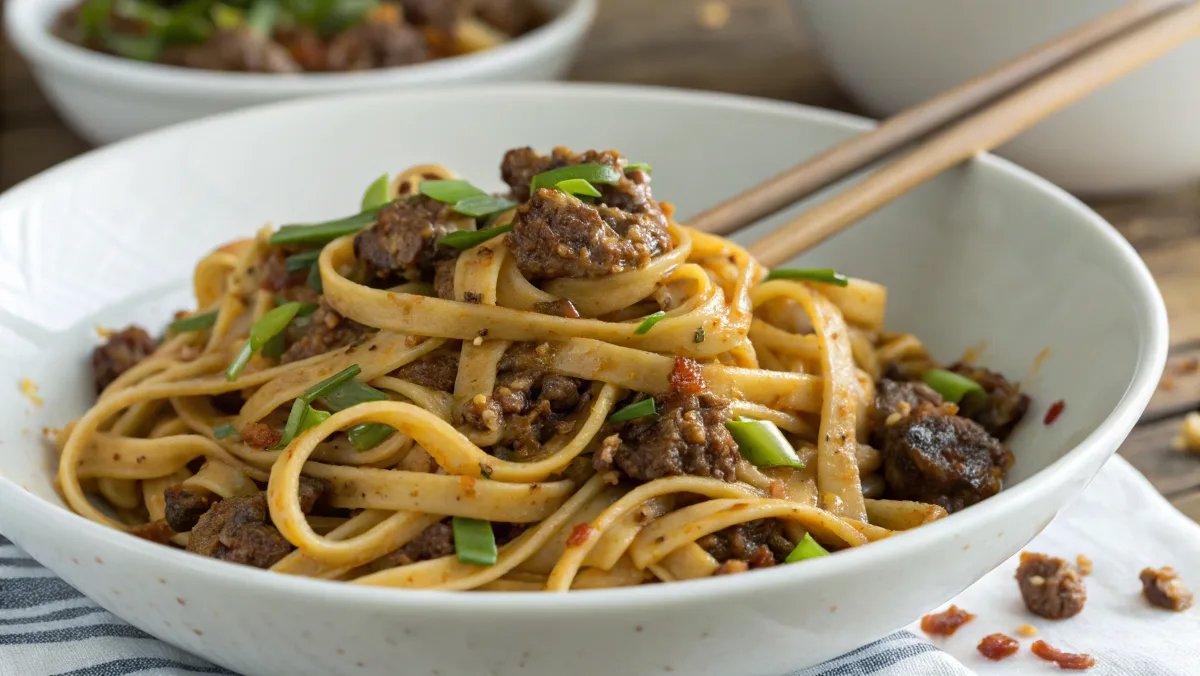Introduction to Mongolian Ground Beef Noodles
Mongolian ground beef noodles are a flavorful and easy-to-make dish that combines the rich, savory notes of Mongolian-style cuisine with the satisfying texture of noodles. This dish is perfect for quick weeknight dinners or when you’re in the mood for something hearty and comforting.
In this article, we’ll explore the origins of this dish, the best ingredients to use, and a step-by-step guide to making it at home. Plus, we’ll answer common questions about Mongolian dishes, provide nutritional information, and share expert tips to master tMongolian Ground Beef Noodles.
Table of Contents
The Origins of Mongolian Ground Beef Noodles
What Are Mongolian Noodles Called?
Mongolian noodles often refer to a fusion-style dish inspired by Asian cuisine, though the term doesn’t originate directly from Mongolia. These noodles are typically stir-fried with a sweet and savory sauce, featuring soy, garlic, ginger, and sugar.
Influence of Mongolian Barbecue
The term “Mongolian” is a nod to the popular Mongolian barbecue style, which involves stir-frying meats and vegetables on a flat iron griddle. Though the style originated in Taiwan, it has become synonymous with bold flavors and customizable dishes.
The Evolution of Ground Beef Noodles
While traditional Mongolian cuisine often emphasizes lamb and hearty stews, the use of ground beef and noodles in this recipe highlights modern adaptations for Western kitchens. Combining tender beef with chewy noodles creates a delicious fusion that’s hard to resist.
Choosing the Right Noodles for Your Recipe
What Type of Noodle Is Used for Mongolian Barbecue?
The noodles commonly used in Mongolian barbecue dishes are thick, chewy, and hearty enough to absorb the flavorful sauces. Popular options include:
- Lo Mein: These soft wheat noodles are ideal for stir-frying and hold sauces well.
- Udon: A thicker noodle with a chewy texture, perfect for a hearty dish like Mongolian ground beef noodles.
- Rice Noodles: A gluten-free alternative, offering a lighter option for those with dietary restrictions.
Exploring Different Types of Asian Noodles
If you’re looking to experiment, here are a few other noodle options to consider:
- Soba Noodles: Made from buckwheat, they add a nutty flavor to your dish.
- Glass Noodles: These transparent noodles made from mung bean starch are a unique addition to the dish.
- Chow Mein Noodles: Thin and crispy noodles are a favorite for stir-fried dishes.
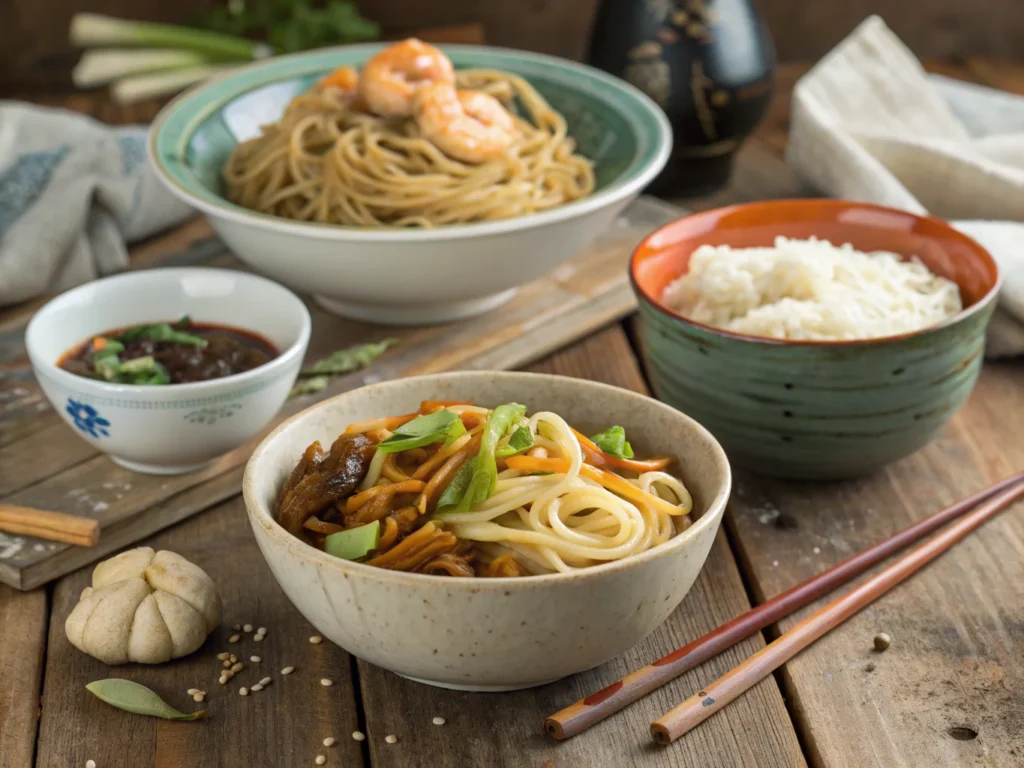
Choose from a variety of noodles to suit your dish.
Thick vs. Thin Noodles – What’s the Best Choice?
The choice between thick and thin noodles largely depends on personal preference and the texture you want to achieve:
- Thick Noodles: Best for soaking up sauce and creating a hearty dish.
- Thin Noodles: Great for a lighter meal with a more delicate texture.
Pro Tip:
Cook the noodles al dente before stir-frying to prevent them from becoming soggy. This ensures they retain their structure when combined with the rich Mongolian sauce.
The Star Ingredient – Ground Beef
Why Ground Beef Works Perfectly in This Dish
Ground beef is a versatile and flavorful ingredient that blends seamlessly with the bold Mongolian-style sauce. Its tender texture and ability to absorb spices make it a top choice for this recipe. Additionally, ground beef is:
- Affordable and Readily Available: A cost-effective protein option.
- Quick to Cook: Perfect for busy weeknight meals.
- Rich in Flavor: Adds a hearty and satisfying taste to the dish.
The Role of Marination in Flavor Infusion
While Mongolian ground beef noodles are quick to prepare, marinating the beef can elevate the flavor. Here’s how:
- Soy Sauce: Provides a salty, umami base.
- Garlic and Ginger: Essential aromatics for authentic Mongolian taste.
- Cornstarch: Helps create a silky texture and thickens the sauce during cooking.
Quick Marination Tip:
Marinate the ground beef for at least 15 minutes. For deeper flavor, let it rest in the refrigerator for up to an hour.
What Is Special About Mongolian Beef?
Mongolian beef stands out for its unique balance of flavors:
- Sweetness: Typically achieved with brown sugar or hoisin sauce.
- Savory Notes: Soy sauce and sesame oil create depth.
- Aromatics: Fresh garlic, ginger, and green onions bring it all together.
- Versatility: The beef can be served with noodles, rice, or even vegetables, making it adaptable to various tastes.
Step-by-Step Recipe for Mongolian Ground Beef Noodles
Essential Ingredients and Preparation
Before diving into the cooking process, gather the following ingredients:
For the Noodles:
- 8 oz of Lo Mein noodles (or your preferred type)
- 1 tablespoon of sesame oil (to prevent sticking)
For the Ground Beef:
- 1 lb of ground beef
- 2 tablespoons of soy sauce
- 1 teaspoon of minced garlic
- 1 teaspoon of grated ginger
- 1 tablespoon of cornstarch
For the Sauce:
- 1/3 cup of low-sodium soy sauce
- 1/4 cup of brown sugar
- 1 teaspoon of sesame oil
- 1/2 teaspoon of chili flakes (optional, for heat)
Garnishes:
- 2 green onions, chopped
- 1 teaspoon of toasted sesame seeds
Detailed Cooking Instructions with Tips
1️⃣: Cook the Noodles
- Boil the noodles according to the package instructions until al dente.
- Drain and toss with sesame oil to prevent sticking. Set aside.
2️⃣: Prepare the Ground Beef
- Heat a large skillet or wok over medium heat.
- Add the ground beef and cook until browned, breaking it into small crumbles.
- Mix in soy sauce, garlic, ginger, and cornstarch, and cook for another 2-3 minutes.
3️⃣: Make the Sauce
- In a small bowl, whisk together soy sauce, brown sugar, sesame oil, and chili flakes.
- Pour the sauce into the skillet with the beef, stirring to coat evenly. Simmer for 2-3 minutes until the sauce thickens slightly.
4️⃣: Combine Noodles and Beef
- Add the cooked noodles to the skillet, tossing gently to combine with the beef and sauce.
- Ensure the noodles are fully coated and heated through.
5️⃣: Garnish and Serve
- Top the dish with chopped green onions and sesame seeds.
- Serve immediately and enjoy the delicious blend of sweet and savory flavors!
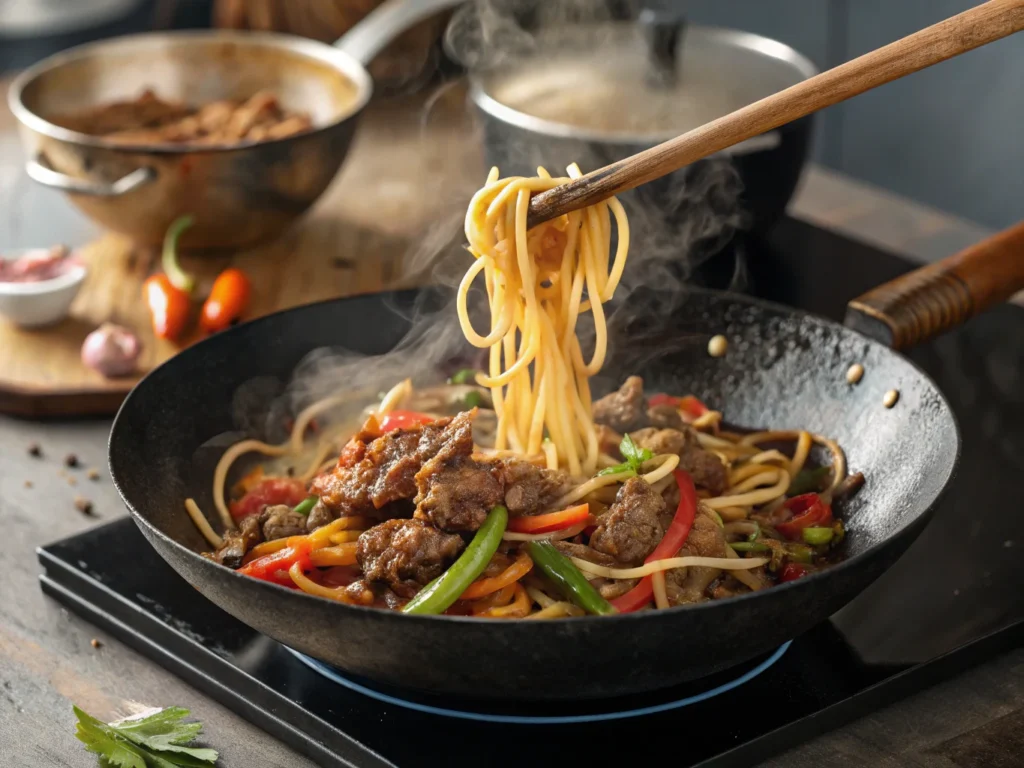
Combine noodles and beef for a delicious dish.
Adding Your Personal Touch for Custom Flavors
- Make It Spicy: Add more chili flakes or a drizzle of sriracha.
- Boost Veggies: Toss in bell peppers, broccoli, or carrots for added nutrition.
- Use Alternative Proteins: Swap ground beef for ground turkey, chicken, or plant-based options.
Nutritional Profile of Mongolian Ground Beef Noodles
Understanding the Calorie Breakdown
Mongolian ground beef noodles are a satisfying dish that strikes a balance between indulgence and nutrition. Here’s a general nutritional estimate for a single serving (based on a recipe yielding 4 servings):
- Calories: ~450-500
- Protein: ~25g
- Carbohydrates: ~55g
- Fats: ~15g
- Fiber: ~3g
This makes it a hearty option that provides energy and nutrients while remaining within a reasonable calorie range for most diets.
How Many Carbs Are in Mongolian Beef Noodles?
Carbohydrates primarily come from the noodles and the sauce (due to the brown sugar). Here’s a quick breakdown of the carb sources:
- Noodles: 40-45g per serving
- Sauce (brown sugar and soy sauce): ~8-10g per serving
- Add-Ons (vegetables, garnishes): 2-5g per serving
Lower-Carb Alternatives:
- Use zucchini noodles or shirataki noodles instead of traditional noodles.
- Replace brown sugar with a low-carb sweetener like stevia or erythritol.
Making It a Balanced Meal with Simple Tweaks
While Mongolian ground beef noodles are delicious on their own, here are a few ways to enhance their nutritional profile:
- Add More Vegetables: Include stir-fried broccoli, snap peas, or carrots for added vitamins and fiber.
- Opt for Leaner Beef: Use lean ground beef (90% lean or higher) to reduce fat content.
- Control Sodium Levels: Choose low-sodium soy sauce to keep salt levels in check.
Pro Tip:
Pair the dish with a fresh side salad or steamed veggies to make it a well-rounded meal.
Perfect Pairings for Mongolian Ground Beef Noodles
Side Dishes That Complement the Recipe
Mongolian ground beef noodles pair wonderfully with light, flavorful sides that enhance the meal without overpowering it. Here are some great options:
- Steamed Vegetables: Broccoli, snow peas, or bok choy provide a fresh, crunchy contrast.
- Asian-Style Salad: A cucumber or seaweed salad with sesame dressing adds a refreshing element.
- Spring Rolls: Light and crispy rolls filled with vegetables or shrimp make a perfect starter.
Beverage Suggestions to Enhance the Experience
The right drink can elevate the flavors of Mongolian ground beef noodles:
- Green Tea: A warm cup of green tea complements the dish’s savory and slightly sweet profile.
- Jasmine Iced Tea: Refreshing and slightly floral, it balances the bold flavors.
- Light Lager or Sake: For an indulgent pairing, these beverages work well with Asian-inspired meals.
Delicious Condiments for Added Spice
To customize your dish to suit individual preferences, serve it with:
- Sriracha or Chili Oil: Adds heat and enhances the depth of flavors.
- Hoisin Sauce: For a sweeter, richer kick.
- Soy Sauce or Tamari: Great for those who love an extra salty tang.
To enhance your Mongolian-inspired meal, you can’t go wrong with bold flavors. Explore our Orange Chicken Recipe for a complementary main dish
Pro Tip:
Offer a variety of garnishes, such as chopped cilantro, toasted peanuts, or lime wedges, for guests to personalize their servings.
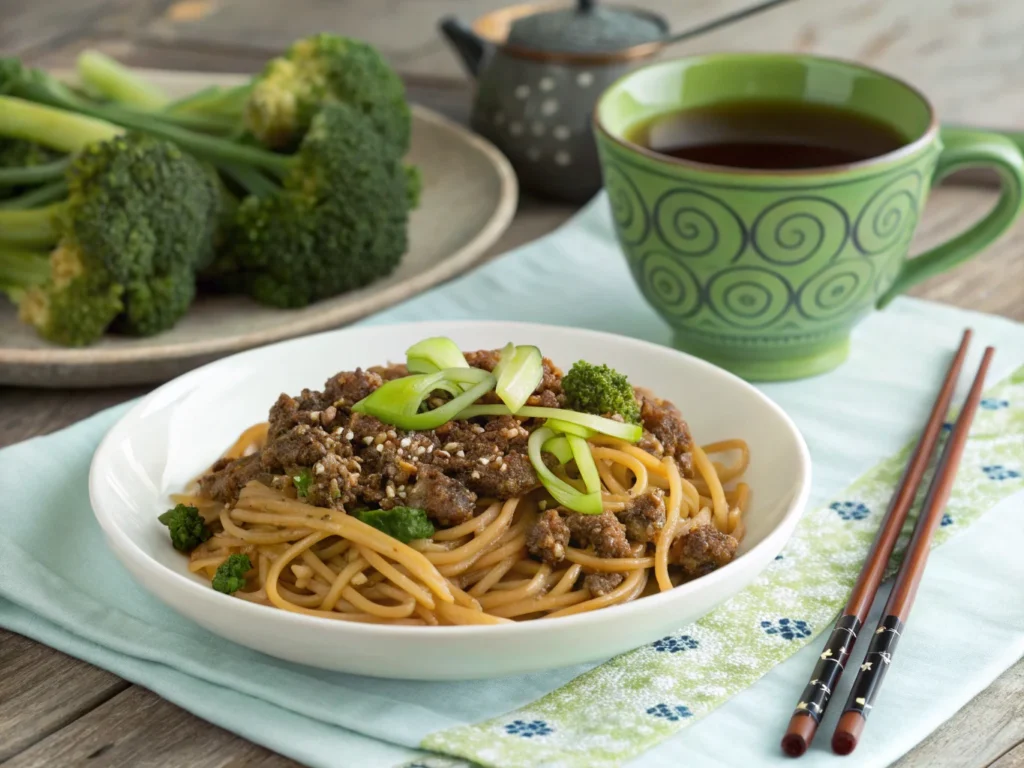
Pair Mongolian ground beef noodles with steamed broccoli and green tea for a complete meal.
Expert Tips to Master Mongolian Ground Beef Noodles
Common Mistakes to Avoid
Creating the perfect Mongolian ground beef noodles can be easy if you sidestep these common pitfalls:
- Overcooking the Noodles: Always cook them al dente. Overcooked noodles can become mushy when stir-fried.
- Using High-Sodium Ingredients: Avoid regular soy sauce if possible. Opt for low-sodium soy sauce to keep the dish flavorful but not overly salty.
- Skipping the Marination: Even a short marination enhances the beef’s flavor, so don’t skip this crucial step.
Secrets to Achieving Restaurant-Quality Flavors
Want your dish to taste like it’s straight out of a restaurant kitchen? Try these tips:
- High Heat Cooking: Use a wok or a skillet over high heat for that characteristic smoky flavor.
- Fresh Ingredients: Fresh garlic, ginger, and green onions make a noticeable difference in flavor.
- Balance the Sauce: Taste-test the sauce and adjust the sweetness, saltiness, or spice according to your preference.
Want to take your cooking skills even further? Check out our Ultimate Guide to Pellet Grill Recipes to learn how to elevate your meals with smoky, grilled flavors.
Pro Tip:
Add a teaspoon of rice vinegar or lime juice for a subtle tang that brightens the flavors.
Storing and Reheating Your Dish the Right Way
Mongolian ground beef noodles are great for meal prep! Here’s how to store and reheat them:
- Storage: Place leftovers in an airtight container and refrigerate for up to 3 days.
- Reheating: Heat in a skillet over medium heat with a splash of water or soy sauce to revive the flavors and prevent drying out.
- Freezing: While the dish can be frozen, the noodles may lose some texture. Freeze the beef and sauce separately, then combine with freshly cooked noodles when reheating.
FAQs
What Are the Thick Chinese Noodles Called?
Thick Chinese noodles commonly used in Mongolian-inspired dishes include:
Udon Noodles: These Japanese-style noodles are popular for their chewy texture and ability to soak up sauces.
Lo Mein: These soft, egg-based wheat noodles are ideal for stir-fry dishes.
Shanghai Noodles: A thick, slightly round noodle often featured in Chinese-style dishes.
These noodles pair exceptionally well with Mongolian sauces due to their sturdy texture.
Is Mongolian Stir-Fry Actually Mongolian?
Interestingly, Mongolian stir-fry doesn’t have direct roots in Mongolia. It originated in Taiwan and was inspired by Chinese cooking techniques. The name “Mongolian” was likely chosen to evoke exotic and bold flavors, appealing to global audiences.
How Many Carbs Are in Mongolian Beef Noodles?
The carb count in Mongolian beef noodles primarily depends on the type of noodles used and the sweeteners in the sauce.
Traditional Noodles: ~40-45g of carbs per serving
Sauce (Brown Sugar): ~8-10g per serving
For a low-carb alternative, you can use zucchini noodles, shirataki noodles, or spaghetti squash to significantly reduce the carb content.
What Type of Noodle Is Used for Mongolian Barbecue?
The most common noodles for Mongolian barbecue are Lo Mein or Udon Noodles. They are thick and sturdy, making them perfect for stir-frying with meats and sauces. These noodles hold up well to the high heat and bold flavors of Mongolian-style dishes.
What Is Special About Mongolian Beef?
Mongolian beef is beloved for its unique balance of flavors:
Sweet and Savory: A combination of soy sauce and brown sugar creates its signature taste.
Garlic and Ginger: These aromatics enhance the dish’s depth and authenticity.
Tender Beef Strips: The meat is often marinated and cooked quickly to achieve a tender, juicy texture.
Conclusion and Final Thoughts
Recap of What Makes Mongolian Ground Beef Noodles Stand Out
Mongolian ground beef noodles combine bold, sweet, and savory flavors with the satisfying texture of noodles, making it a favorite for quick, hearty meals. This dish is easy to prepare, adaptable to various dietary preferences, and a perfect choice for family dinners or meal prep.
We’ve explored its origins, the best noodles to use, the magic of ground beef, and how to create a balanced, restaurant-quality dish. By following the tips and variations shared, you can make Mongolian ground beef noodles your own and enjoy a dish that’s as versatile as it is delicious.
Encouragement to Try the Recipe Today
Whether you’re a seasoned cook or just starting out in the kitchen, this recipe is simple enough to master yet impressive enough to serve to guests. With minimal prep time and maximum flavor, it’s a go-to dish that’s sure to become a staple in your home.
If this recipe has inspired you, don’t miss our guide on Leftover Rotisserie Chicken Recipes for more creative and delicious meal ideas.
Learn More Recipes to Expand Your Culinary Repertoire
Looking to explore more Asian-inspired dishes?
- Discover Southern Cornbread Recipe for a comforting side dish.
- Try Smoked Mac and Cheese for a smoky twist on a classic favorite.
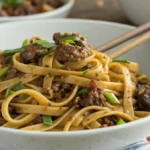
Mongolian Ground Beef Noodles – A Deliciously Simple Recipe
- Total Time: 30 minutes
Description
A savory and easy-to-make dish combining tender ground beef, chewy noodles, and a rich Mongolian-style sauce. Perfect for a quick dinner or meal prep.
Ingredients
- For the Noodles:
- 8 oz Lo Mein noodles
- 1 tablespoon sesame oil
- For the Ground Beef:
- 1 lb ground beef
- 2 tablespoons soy sauce
- 1 teaspoon minced garlic
- 1 teaspoon grated ginger
- 1 tablespoon cornstarch
- For the Sauce:
- 1/3 cup low-sodium soy sauce
- 1/4 cup brown sugar
- 1 teaspoon sesame oil
- 1/2 teaspoon chili flakes (optional)
- For Garnish:
- 2 green onions, chopped
- 1 teaspoon toasted sesame seeds
Instructions
- Cook the Noodles: Boil the noodles according to package instructions until al dente. Drain, toss with sesame oil, and set aside.
- Prepare the Ground Beef: Heat a skillet over medium heat. Brown the ground beef, breaking it into crumbles. Add soy sauce, garlic, ginger, and cornstarch. Cook for 2-3 minutes.
- Make the Sauce: Whisk together soy sauce, brown sugar, sesame oil, and chili flakes in a small bowl. Add the sauce to the skillet and stir well. Simmer for 2-3 minutes until the sauce thickens slightly.
- Combine Noodles and Beef: Add the cooked noodles to the skillet and toss to coat in the sauce. Heat through.
- Serve: Garnish with chopped green onions and toasted sesame seeds. Serve immediately and enjoy!
Notes
- For a lower-carb option, substitute Lo Mein noodles with zucchini noodles or shirataki noodles.
- Add stir-fried vegetables like broccoli or carrots for extra nutrition.
- Adjust sweetness or heat by tweaking the sugar and chili flakes to taste.
- Prep Time: 15 minutes
- Cook Time: 15 minutes
- Category: Dinner
- Cuisine: Asian
Nutrition
- Serving Size: Approximately 1.5 cups
- Calories: ~450
- Sugar: ~10 g
- Sodium: ~950 mg
- Fat: ~15g
- Carbohydrates: ~55 g
- Fiber: ~3 g
- Protein: ~25g
- Cholesterol: ~55 mg

